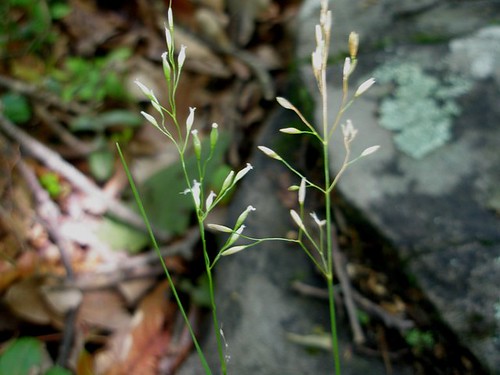 Species Factsheets
Species Factsheets
Piptatheropsis pungens
Slender Mountain-ricegrass
State Status: Pennsylvania Endangered (PE)
PBS Status: Pennsylvania Endangered (PE)
Federal Status:
Global Rank: G5
![]() rank interpretation
rank interpretation
State Rank: S2
Description
Slender Mountain-ricegrass is a perennial grass that grows in a tufted clump and produces erect stems that may reach 0.5 m in height. The leaves are alternately arranged, consisting of a basal sheath portion that envelopes the stem and an extremely narrow, flattened or inrolled, and untoothed blade that is up to 0.3 m in length, about 2 mm in width, and pointed at the tip. The minute flowers, appearing primarily in May and June (but sometimes sporadically later in the year), occur in a relatively short and few-branched cluster, or inflorescence, at the tip of the stem. The inflorescence contains many individual spikelets about 3-4 mm in length, with each including a single flower and later a single fruit. The tip of the spikelet usually has a tiny hair-like projection, or awn, which is 1-2 mm in length, but is rather delicate and often breaks off. In summer, well after the fruits have fallen, the species may often be identified by the persistence of the inflorescence, which turns pale brown and has a short, few-branched appearance.
Rank Justification
Imperiled in the nation or state because of rarity due to very restricted range, very few populations (often 20 or fewer), steep declines, or other factors making it very vulnerable to extirpation from the nation or state.
Habitat
It grows in well-drained, sandy habitats that receive considerable sun, such as rocky open woods, bedrock outcrops, heath barrens, balds, and mountain summits.
Survey Dates
Flowers May
Distribution
Slender Mountain-ricegrass has a transcontinental range across the cooler regions of North America. In Pennsylvania, it represents a northerly species and has been documented historically in a few northeastern counties.

Management
Most populations of Slender Mountain-ricegrass in Pennsylvania are situated in remote areas where the habitat is likely to be kept in a natural state. Active management, such as the use of prescribed fire, may be beneficial in maintaining these areas or in creating additional habitat.
Conservation Status Map

NatureServe. 2017. NatureServe Explorer: An online encyclopedia of life [web application]. Version 7.1. NatureServe, Arlington, Virginia. Available https://explorer.natureserve.org.
- NatureServe. 2018. NatureServe Explorer: An online encyclopedia of life [web application]. Version 7.1. NatureServe, Arlington, Virginia. Available at https://www.natureserve.org/explorer
- Pennsylvania Natural Heritage Program. 2018.
- Rhoads, A.F. and W.M. Klein, Jr. 1993. The Vascular Flora of Pennsylvania. American Philosophical Society, Philadelphia, Pennsylvania. Rhoads, A.F. and T.A. Block.
- 2007. The Plants of Pennsylvania: An Illustrated Manual. 2nd edition. University of Pennsylvania Press, Philadelphia, Pennsylvania.







